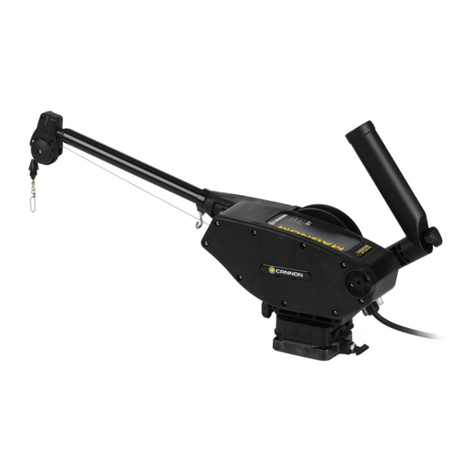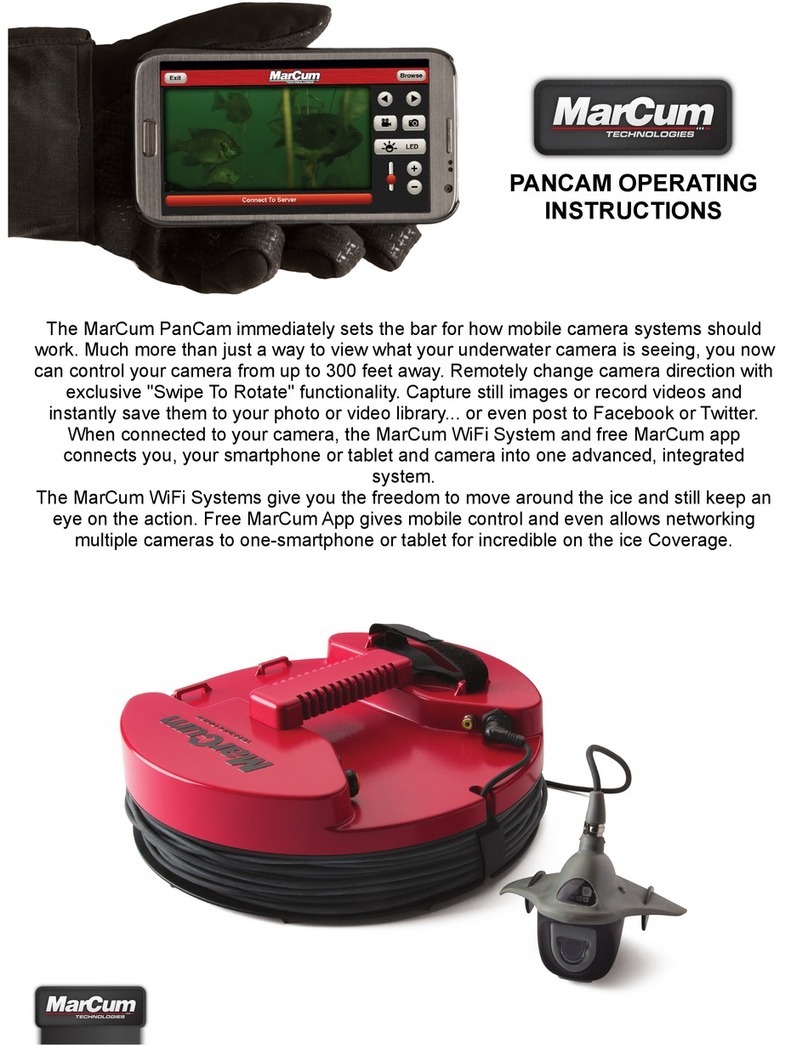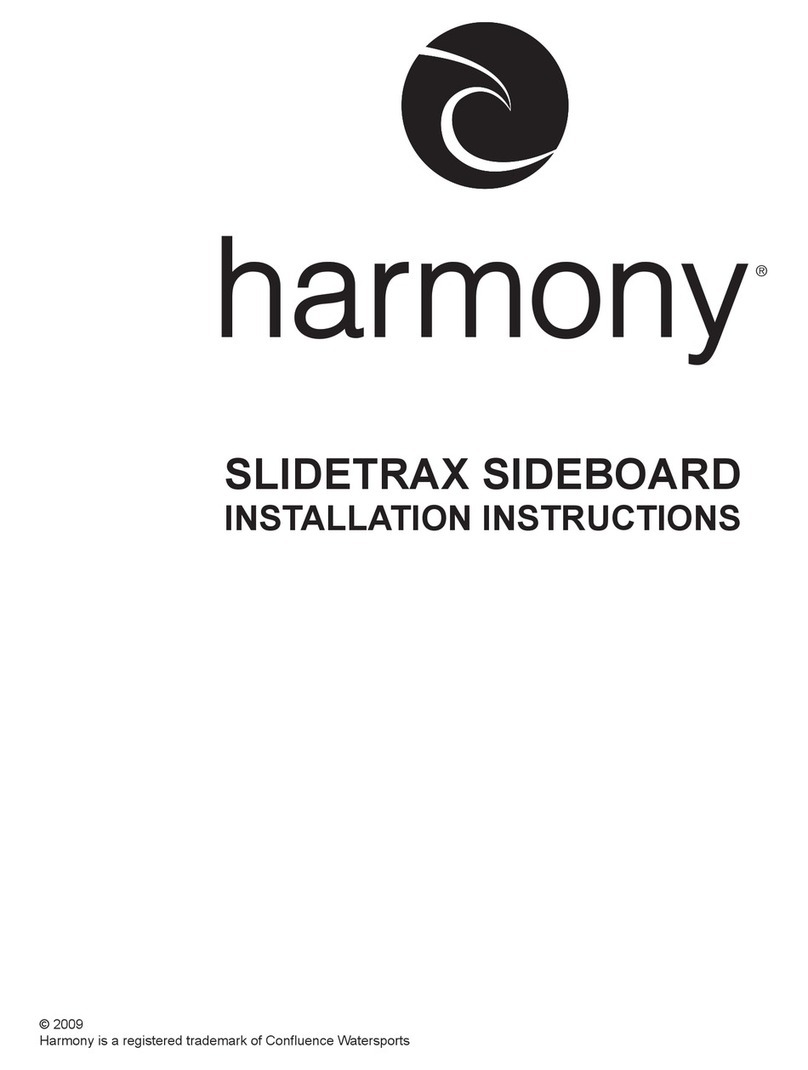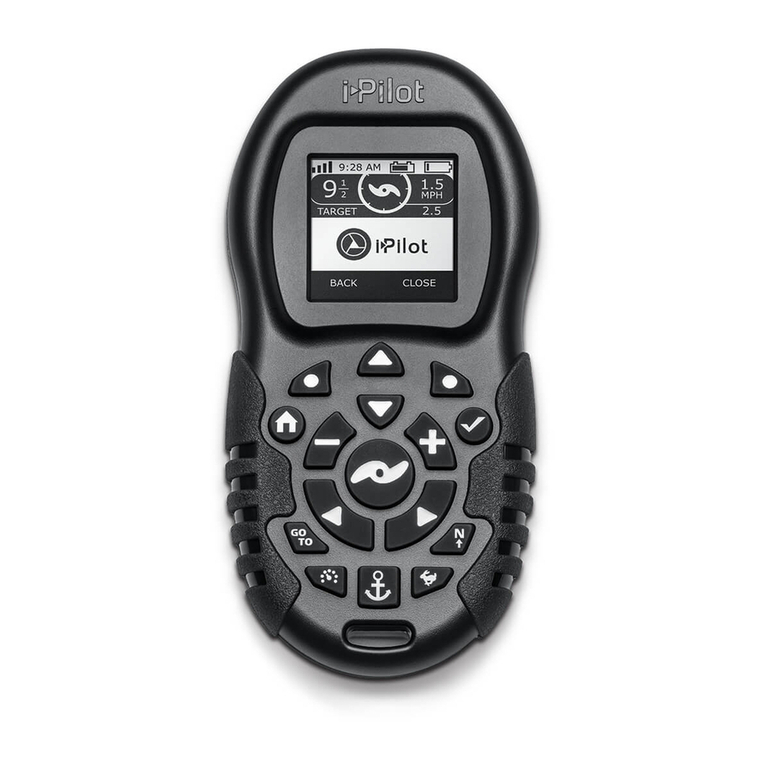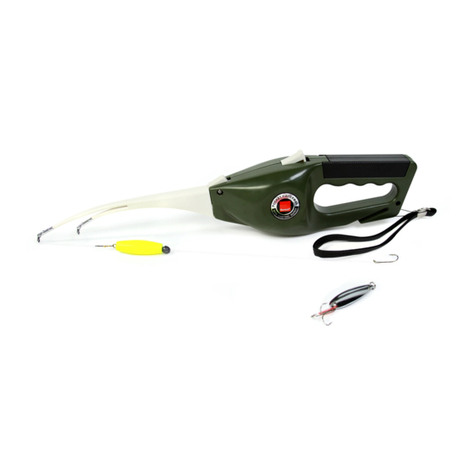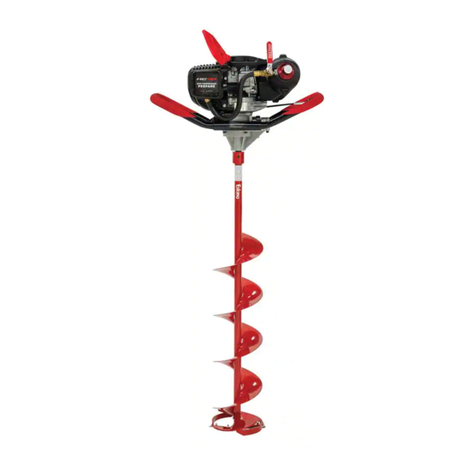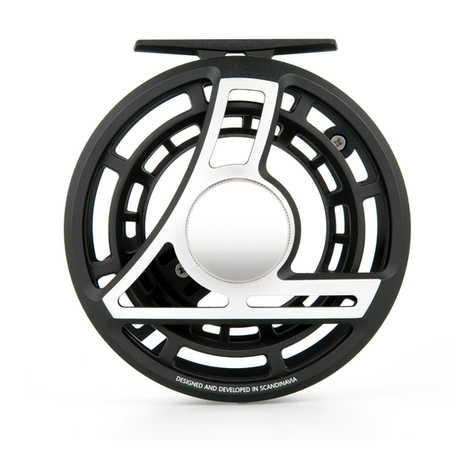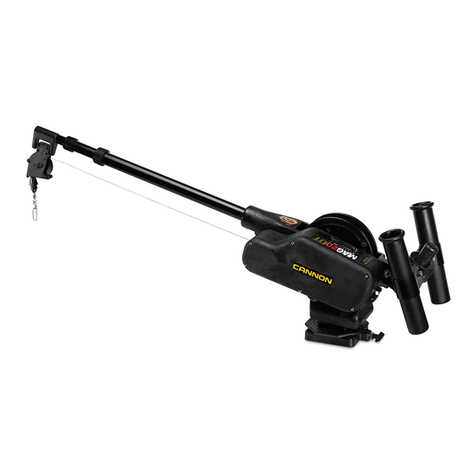Slider HART User manual

MODE D’EMPLOI ............. 20
MANUAL DO
UTILIZADOR..................... 26
www.hart-outdoor.com
EN FR
ES PT
DE
USER´S GUIDE.......................2
MANUAL DE USUARIO..........8
BENUTZERHANDBUCH ......14

EN USER´S GUIDE - HART FLOAT TUBES
2
BEFORE YOU GET STARTED, please read this manual carefully.
This User´s Guide will help you to correctly assemble your new HART oat tube and to
enjoy it safety. It o ers basic safety instructions, maintenance tips, and explains how
you can do some simple repairs yourself.
TABLE OF CONTENTS
ASSEMBLY INSTRUCTIONS
1. List of parts.
2. How to in ate/de ate the oat tube.
CARE AND MAINTENANCE
1. Transport.
2. Cleaning and maintenance.
3. Storage:
a. Short-term storage.
b. Long-term storage (winter)
4. Troubleshooting.
5. Repair instructions.
• This fl oat tube is not a toy. Minors must always use it under adult supervision.
• If this is your fi rst experience with a fl oat tube, please check with your local
dealer in order to ensure that you are able to use it safely.
• Always consider the fi shing conditions such as currents, winds, waves. Be
aware of your own physical limitations and those of your personal protective
equipment.
• When using your new HART fl oat tube, we would advise you not to fi sh
alone. If you do so, then you need to inform someone close to you of the
place where you are planning on fi shing, your itinerary and schedule.
• When out fi shing, always use a CE approved life-jacket.
• Get information on the applicable legislation and regulations on the use of
fl oat tubes in your fi shing area, province and/or Water Board.
¡WARNING!

EN
HART FLOAT TUBES - USER´S GUIDE
3
TABLE OF CONTENTS
ASSEMBLY INSTRUCTIONS
1. List of parts.
2. How to in ate/de ate the oat tube.
CARE AND MAINTENANCE
1. Transport.
2. Cleaning and maintenance.
3. Storage:
a. Short-term storage.
b. Long-term storage (winter)
4. Troubleshooting.
5. Repair instructions.
ASSEMBLY INSTRUCTIONS
1. LIST OF PARTS
Inside the box you will nd information of the components for
the HART oat tube you have purchased. Please check that
the box contains each part indicated.
The repair kit contains:
- 1 PVC patch
- 1 tube of adhesive
- Valve extractor
2. HOW TO INFLATE/DEFLATE AND ASSEMBLE
THE FLOAT TUBE
Maximum in ation pressure:
SLIDER (High Pressure Models):
• 1 bar/14,5 psi for the main shell and seat.
• 0,25 bar/3,6 psi for the small side tubes.
SIKKARIO / GUARDIAN / VENDETTA (PVC Models):
• 0,25 bars/3,6 psi for the main tubes.
•1 bar/14,5 psi for the high pressure oor and seat (not available in all models.
Check whether your oat tube has this feature).
How to in ate the oat tube:
1. Choose a site with enough room and spread out the PVC shell. You need to bear in
mind that, once in ated, the oat tube takes up more room than when de ated.
2. Check that the site is free from sharp edges or objects that could puncture the PVC
during in ation, handling or moving it to the water.
3. Open the cap on each of the valves and give the inner round stem 1/4 of a turn
counter-clockwise to open the airway. It should then be in the “air inlet” position. In this
way, no air will escape once the pump is removed from the valve opening.
4. In ate each of the air chambers up to approximately
half capacity. This will allow you to mount the oor
and seat between the two sides. For the high pressure
Slider model, the main structure and the side tubes
should be fully in ated (taking care not to exceed the
maximum pressure levels).
5. If your oat tube model includes a high pressure
oor or seat, then these should be fully in ated and
• Infl ate only with a HART pump. Other systems could damage the fl oat tube
or even cause it to burst due to overpressure.
• NEVER USE the infl ation pumps available at service and petrol stations.

EN USER´S GUIDE - HART FLOAT TUBES
4
placed in the right position on the shell formed by the
main tubes. Mount the rear net, if your model has this
feature.
6. Continue to in ate the main tubes up to the nal
pressure (maximum 0.25bar/3.6 psi). Then close the
valves (with 1/4 of a turn clockwise).
7. Should there be a problem during the in ation
process, then completely de ate the tube in question
and half de ate the other one (see “De ation” below). Check that the fabric lies at and
is not twisted, preventing correct air ow. Go back to point 4 and repeat the procedure.
8. If your oat tube model is equipped with oars as accessories, then assemble the
parts and x them securely to the supports.
9. The spreader bar and the front plastic-coated stripping apron (for those oat tube
models that include these accessories) should be secured to the tubes once you are
seated on the oat tube, in the water.
10. The Slider model also has a keel and keel support,
“torpedo” type electric motor support and “standard”
type outboard electric motor. If you are going to use a
oat tube with an outboard electric motor, the motor
support should be mounted in the correct position. If
you are going to use a torpedo type electric motor or
the keel, then mount them on the support just when
you are going to put the oat tube in the water, to
avoid damage.
Maximum recommended load:
Your oat tube has a maximum recommended load of:
• 200 kilos - models: SLIDER, GUARDIAN, SIKKARIO
• 130 kilos - models: VENDETTA.
• Once the fl oat tube has been infl ated to its operating pressure, it should
not be left out of the water in direct sunlight for long periods of time. High
temperatures could increase the air pressure inside the craft, causing it to
expand. This overpressure could burst the fl oat tube bladders.
• If you need to take your fl oat tube out of the water for some time, leaving
it exposed to the sun, then simply partially defl ate it by approximately one
quarter of its air volume.
• On extremely hot days, there may be overpressure, even when fi shing in the
water. Should this happen, simply correct this overpressure by releasing the
excess air until the correct pressure has been reached.

EN
HART FLOAT TUBES - USER´S GUIDE
5
De ation:
11. With the oat tube still in ated, rinse it with water and check its surface for any
possible damage from branches, underwater rocks or anything else that may have
punctured it.
12. Leave the oat tube to air dry and then fully de ate. This will ensure that, when
folded, there are no damp areas which would lead to bad odours or stains on the PVC.
You can also use a micro bre or similar cloth to help dry it more quickly.
13. Remove the caps from all the valves and put the
valves in the air outlet position. To do so, press down
on the valve stem and give it a quarter of a turn until it
is xed in this new position, to allow the air to escape.
14. To remove any residual air, press down on the oat
tube surface towards the valves, until it is completely
de ated.
CARE AND MAINTENANCE
1.TRANSPORT
To avoid excessive wear and to extend the useful life of your HART oat tube, we would
advise you to always carry it in the bag supplied with your product.
During transport, do not load other objects on top of it, particularly heavy or sharp
objects.
If you are transporting your HART oat tube in in your car boot or trunk, make sure that
you’ve taken out any sharp objects rst, including chemicals such as oils or others.
IMPORTANT: Much of the damage to oat tubes does not takes place when out shing
but during transport.
THE VALVE CAPS MUST BE CORRECTLY IN PLACE WHEN TRANSPORTING YOUR
FLOAT TUBE.
2.CLEANING AND MAINTENANCE
Your HART oat tube is constructed by professionals, using high-resistance PVC, top
quality components and materials.
As is the case with any outdoor equipment, correct cleaning and maintenance will help
to lengthen the useful life of the oat tube, for optimum performance and many years
of enjoyment.
• If you have enough room, store the semi-infl ated fl oat tube in a dark, dry
place such as a storeroom or garage. If this is not possible, then make sure
that the fl oat tube is completely clean and dry and store it in its carry bag.
• For storage over long periods of time: Clean the fl oat tube with neutral soap
and water before storing it for the winter.
• See the “Storage” section of this manual for more details.

EN USER´S GUIDE - HART FLOAT TUBES
6
Prolonged exposure to UV rays, the eect of chemicals, insect repellents and mildew
are all damaging to your oat tube. To lengthen the life of your HART oat tube, follow
these simple instructions:
• Do not put your oat tube on sharp objects.
• Do not put heavy objects or objects with sharp edges on your oat tube.
• Do not over-inate your oat tube.
• Keep the valves and zips clean.
• Regularly clean your oat tube with neutral soap and water.
• Before transporting your HART oat tube, make sure that it is fully deated.
3. STORAGE
3a. Short-term storage:
Once clean, leave your oat tube to air dry. Deate it and roll it up without pressing down
too much. The valves must be in the “open” position, making it possible to release any
residual air that may be inside.
3b. Long-term storage (winter):
Before storage, make sure that your HART oat tube is perfectly clean and dry. After
use, carefully rinse your oat tube to remove any debris and leave it to air dry on a
smooth, clean surface, away from direct sunlight.
Store your oat tube in a cool, dry place, away from direct sunlight and from chemicals
and exhaust fumes.
If you are going to leave your oat tube partially inated during storage, then check that
you can pinch 2.5 cm of material, this is the ideal pressure.
4. TROUBLESHOOTING
Air escapes from the valve when the pump is removed...
• Is the valve in the “air inlet” position? If this is the case, then remove any debris
that could aect the airtightness of the valve. To do so, quickly pump small bursts of air
into the valve. If the fault persists, then take out the core valve assembly, use a cotton
bud and alcohol to clean the rubber O-ring edge and then re-mount without tightening
excessively.
• Ensure that the core valve assembly is correctly tightened. Remove/mount and
retighten the valve if necessary.

EN
HART FLOAT TUBES - USER´S GUIDE
7
The oat tube loses air and goes “soft” after ination...
• Check which chamber is aected. Check that the valve is working correctly and
that there are no leaks. Is the chamber punctured or damaged? Go to the “Repair
Instructions” section of this manual.
The pocket zip is stuck.
• Use water, soap and a toothbrush to clean the zip and remove any debris. Rinse
with plenty of clean water and check that the zip is now working correctly.
The repair kit patch does not stick to the tube...
• Make sure that the area to be repaired is clean and dry. Correctly prepare the
surface to be repaired (see the “Repair Instructions” section of this manual).
5. REPAIR INSTRUCTIONS
15. Use soapy water and a sponge to locate the leak on the craft, in the same was as
for the inner tube of a tyre, and mark it with chalk (look for the bubbles escaping due
to loss of air).
16. Use a towel or cloth to dry the area to be repaired.
17. Cut a patch of repair material that is at least three centimetres longer and wider
than the snag, hole or tear.
18. Thoroughly clean the area to be repaired by wiping with cotton wool soaked in
alcohol.
19. Use sandpaper to rough up the areas in contact with the patch and the area to be
repaired.
20. Open the adhesive container and prepare the adhesive by pouring the contents of
the jar into the metal container. Stir with a wooden stick.
21. Use a brush to apply a coat of adhesive, that is uniform and not to thick, to the patch
and also to the area to be repaired. Leave to dry separately until it is no longer sticks to
your ngers when touched (this takes about 10 minutes).
22. If necessary, apply a second coat of adhesive to the patch and area to be repaired
and leave to dry for a further 5 minutes or until it acquires a certain consistency.
23. Centre the patch over the hole or tear and press down. Use a roller or other round
object and press down from the centre of the patch towards the edges in order to seal it
to the outer skin. Make sure that the patch seals completely and has bonded perfectly.
24. Let the adhesive dry for at least 24 hours before inating the oat tube. Never inate
to full pressure on the same day as the repair.
25. If air is escaping from the oat tube through one of the valves, then use the plastic
wrench included in the repair kit to remove the valve, carefully clean the valve and
O-ring with a damp cloth and remount, tightening with the wrench, without forcing it,
until it is perfectly screwed down.
26. For any major repairs, check with your authorised HART dealer.

ES MANUAL DE USUARIO - PATOS HART
8
ANTES DE EMPEZAR lea detenidamente este manual.
Este Manual de Instrucciones le ayudará en el proceso de montaje y disfrute de su
nuevo pato HART con seguridad. En él encontrará recomendaciones de seguridad
básicas, consejos de mantenimiento, así como algunas reparaciones sencillas que
podrá realizar usted mismo.
ÍNDICE
INSTRUCCIONES DE MONTAJE
1. Lista de componentes.
2. In ado/desin ado del pato.
CUIDADO Y MANTENIMIENTO
1. Transporte.
2. Limpieza y mantenimiento.
3. Almacenamiento:
a. Almacenamiento a corto plazo.
b. Almacenamiento a largo plazo (invernaje)
4. Solución de problemas.
5. Instrucciones de reparación.
• Este pato no es un juguete. Los menores de edad deberán usarlo siempre
bajo la supervisión de un adulto.
• Si se trata de su primera experiencia con un pato, por favor consulte con
su distribuidor local con el fi n de asegurarse de que está capacitado para
utilizarlo con total seguridad.
• Tenga siempre en cuenta las circunstancias del escenario de pesca,
corrientes, viento, oleaje, sus propias limitaciones físicas y las de su equipo
personal.
• Recomendamos que siempre que utilice su nuevo pato HART vaya
acompañado. Si usted pesca solo, informe a su entorno del lugar, itinerario y
horario previsto para la jornada de pesca.
• En acción de pesca, use siempre un chaleco salvavidas con certifi cación
CE.
• Infórmese sobre la legislación vigente y regulaciones sobre el uso de patos
en su zona de pesca, provincia y/o Confederación Hidrográfi ca.
¡ADVERTENCIA!

ES
PATOS HART - MANUAL DE USUARIO
9
ÍNDICE
INSTRUCCIONES DE MONTAJE
1. Lista de componentes.
2. In ado/desin ado del pato.
CUIDADO Y MANTENIMIENTO
1. Transporte.
2. Limpieza y mantenimiento.
3. Almacenamiento:
a. Almacenamiento a corto plazo.
b. Almacenamiento a largo plazo (invernaje)
4. Solución de problemas.
5. Instrucciones de reparación.
INSTRUCCIONES DE MONTAJE
1.LISTA DE COMPONENTES
En el interior de la caja encontrará información de los
componentes del modelo de pato HART que ha adquirido.
Por favor, compruebe que en el interior se encuentran
todos y cada uno de ellos.
El kit de reparación contiene:
- 1 pieza de PVC
- 1 tubo de pegamento
- Llave extractora de válvula
2. INFLADO/DESINFLADO Y MONTAJE DEL PATO
Presión máxima de in ado:
SLIDER (Modelos Alta Presión):
• 1 bar/14,5 psi para la estructura principal y el asiento.
• 0,25 bar/3,6 psi para los balones laterales.
SIKKARIO / GUARDIAN / VENDETTA (Modelos de PVC):
• 0,25 bars/3,6 psi para los balones principales.
•1 bar/14,5 psi para el asiento y suelo de alta presión (En los modelos que lo
incluyan).
Proceso de in ado:
1. Desplegar la estructura de PVC en un emplazamiento su cientemente amplio. Tenga
en cuenta que el pato una vez hinchado ocupará un volumen superior al inicial.
2. Compruebe que en el lugar elegido no existen salientes a lados ni elementos
punzantes que puedan dañar el pato en el momento del hinchado, manejo o
desplazamiento hasta el agua.
3. Abrir el tapón de cada una de las válvulas
presionando la pestaña cilíndrica y dando ¼ de
vuelta en sentido contrario a las agujas del reloj a la
pestaña cilíndrica interior. Debe quedar en posición
de “entrada de aire”. De esta forma, al separar el
hinchador de la boca de la válvula no se perderá
aire.
4. In ar cada uno de los compartimentos de aire
aproximadamente hasta la mitad de su capacidad
para permitir la colocación del suelo y el asiento entre ellos. En el modelo Slider, de
alta presión, se in ará completamente, tanto la estructura principal como los balones
laterales (atención, no sobrepasar las presiones máximas de in ado).
• No utilice métodos de hinchado diferentes a las bombas HART ya que
pueden producir daños e incluso roturas por sobrepresión.
• NO UTILIZAR NUNCA las bombas de infl ado que encontrará en estaciones
de servicio y gasolineras.

ES MANUAL DE USUARIO - PATOS HART
10
5. Si su modelo de pato incluye suelo o asiento
de alta presión, proceda a in arlos por completo y
colocarlos en la posición adecuada en la estructura
formada por los balones principales. Monte la red
trasera si dispone de ella.
6. Continuar el in ado de los balones principales
hasta alcanzar la presión nal (máximo 0,25bar/3,6
psi). A continuación se deben cerrar las válvulas
(efectuando ¼ de giro en la dirección de las agujas del reloj).
7. En caso de que se produzca algún problema durante el in ado, desin e por completo
el balón afectado y el otro hasta la mitad (ver “Proceso de desin ado” en este mismo
manual). Compruebe que el tejido no esté doblado o pinzado impidiendo la correcta
circulación del aire. Repita el proceso desde el punto 4.
8. Si su modelo de pato dispone de remos auxiliares, ensamble las partes y fíjelos con
rmeza a los soportes.
9. La barra estabilizadora y la red frontal plasti cada (en el caso de que se su modelo
de pato incluya estos accesorios) se deben jar a los balones en el momento en el que
estemos sentados en el pato, dentro del agua.
10. El modelo Slider dispone además quilla y soporte
para quilla, soporte para motor eléctrico tipo
“torpedo” y soporte para motor eléctrico exterior
tipo “standard”. Si va a utilizar en pato con motor
eléctrico exterior, proceda a montar el soporte del
mismo en la posición adecuada. Si va a utilizar un
motor eléctrico tipo torpedo o la quilla, proceda a
colocarlos en el soporte cuando vaya a meter el pato
en el agua para evitar dañarlos.
Carga máxima recomendada:
La carga máxima recomendada es de:
• 200 kilos - modelos SLIDER, GUARDIAN y SIKKARIO
• 130 kilos - modelos VENDETTA.
• Una vez que el pato se encuentra infl ado a su presión de utilización no
lo deje fuera del agua directamente expuesto al sol durante un tiempo
prolongado. Las altas temperaturas provocarán que el aire que se encuentra
en el interior del pato se expanda y genere problemas de sobrepresión que
pueden dañar gravemente los balones.
• Si fuera necesario sacar el pato del agua durante un tiempo y dejarlo
expuesto al sol, es sufi ciente con desinfl ar aproximadamente un cuarto del
volumen de aire.
• En días de calor extremo, puede existir sobrepresión incluso en acción
de pesca dentro del agua. Si se diera el caso, solo es necesario aliviar esa
sobrepresión eliminando el exceso de aire hasta alcanzar la presión correcta.

ES
PATOS HART - MANUAL DE USUARIO
11
Proceso de desin ado:
11. Con el pato todavía in ado, limpie con agua y repase su super cie en busca de
posibles daños por ramas, rocas sumergidas u otro tipo de elementos que hayan
podido causar algún deterioro.
12. Deje secar el pato antes de deshincharlo completamente para que al doblarlo no
queden zonas húmedas que generen malos olores o manchas en el PVC. Puede ayudar
al secado con un paño de micro bra o similar.
13. A oje los tapones de todas las válvulas (poner
éstas en posición de salida de aire). Para ello
presionaremos la pestaña cilíndrica interior y la
giraremos ¼ de vuelta hasta jarla en esta nueva
posición, en la que saldrá el aire.
14. Para extraer el aire residual haga presión sobre la
super cie del pato en dirección a las válvulas hasta
que quede deshinchado por completo.
• Si dispone del espacio adecuado, guarde el pato parcialmente infl ado en un
lugar seco y oscuro, como el trastero o garaje. Si no fuera posible asegúrese
de guardarlo completamente seco y limpio en su bolsa de transporte.
• Para el almacenaje por largos periodos de tiempo: Limpie el pato con agua
y jabón neutro antes del invernaje.
• Vea la sección “Almacenamiento” de este manual para más detalles
CUIDADO Y MANTENIMIENTO
1.TRANSPORTE
Para evitar un desgaste excesivo y alargar la vida útil de su pato HART, recomendamos
transportarlo siempre en la bolsa suministrada con el producto.
Durante el transporte no coloque objetos encima de su pato HART, en particular es muy
importante evitar objetos pesados o cortantes.
Si va a transportar su pato HART en el maletero de un coche, asegúrese de retirar antes
todos los objetos que puedan producir daños, incluidos los productos químicos como
aceites u otros.
IMPORTANTE: Una parte importante de los daños en los patos no se dan en acción de
pesca, sino que suelen producirse durante el transporte.
ASEGÚRESE DE QUE LOS TAPONES DE LAS VÁLVULAS ESTÉN CORRECTAMENTE
COLOCADOS DURANTE EL TRANSPORTE DE SU PATO.
2.LIMPIEZA Y MANTENIMIENTO
Su pato HART está construido con PVC de alta resistencia, componentes y materiales
de primera calidad, y por mano de obra cuali cada.
Como con cualquier equipo de exterior, una limpieza y mantenimiento adecuados
ayudarán a alargar la vida útil del producto y permitirán un rendimiento y disfrute
óptimos durante muchos años.

ES MANUAL DE USUARIO - PATOS HART
12
Su pato hinchable corre el riesgo de sufrir daños tras una exposición prolongada a los
rayos UVA y por el efecto de productos químicos, insecticidas y moho.
Para alargar la vida de su pato HART, siga estas sencillas instrucciones:
• No coloque su pato sobre objetos cortantes.
• No coloque objetos pesados ni con bordes cortantes sobre el pato.
• No ine en exceso su pato.
• Mantenga limpias las válvulas y las cremalleras.
• Limpie su pato a menudo con agua y jabón neutro.
• Vacíe completamente de aire su pato HART antes de transportarlo.
3. ALMACENAMIENTO
3a. Almacenamiento a corto plazo:
Una vez limpio, deje secar su pato al aire libre. Desínelo y enróllelo sin apretar en
exceso. Las válvulas deben quedar en posición “abierta”, permitiendo la salida del aire
residual que haya podido quedar en el interior.
3b. Almacenamiento a largo plazo (invernaje):
Guarde su pato HART perfectamente seco y limpio. Después de su uso, aclare
cuidadosamente el pato para eliminar cualquier residuo y déjelo secar al aire libre sobre
una supercie lisa y limpia, protegido de la luz solar directa.
Guarde el pato en un lugar fresco y seco, protegido de la luz solar directa y lejos de
productos químicos o gases de escape.
Si almacena su pato parcialmente inado, compruebe que puede pellizcar unos 2,5 cm
de tejido, ésa presión es la idónea.
4.SOLUCIÓN DE PROBLEMAS
La válvula no retiene el aire tras retirar la bomba…
• ¿La válvula está en la posición de “llenado”? Si es así, retire cualquier residuo que
pueda afectar a la estanqueidad de la válvula, bombeando pequeñas cantidades de
aire rápidamente. Si el fallo permanece, extraiga el conjunto principal de la válvula,
limpie el borde de la junta tórica de goma con un palito de algodón y alcohol, vuelva a
montar sin apretar en exceso.
• Asegúrese de que el conjunto principal de la válvula está bien apretado. Desmontar/
montar, y reapretar la válvula si fuera necesario.

ES
PATOS HART - MANUAL DE USUARIO
13
El pato pierde aire y se “ablanda” tras nalizar el proceso de inado…
• Compruebe cuál es el balón de aire afectado. Asegúrese de que la válvula
correspondiente funciona correctamente y de que no existe fuga alguna. ¿Presenta
algún pinchazo o deterioro? Pase a la sección “Instrucciones de reparación” de este
manual.
La cremallera de los bolsillos se resiste.
• Utilice agua, jabón y un cepillo de dientes para limpiar la cremallera y eliminar
los residuos. Aclare con agua limpia abundante y compruebe el funcionamiento de la
cremallera de nuevo.
El parche del kit de reparación no se adhiere…
• Asegúrese de que el área a reparar esté limpia y seca. Prepare bien la supercie a
reparar (ver apartado “Instrucciones de reparación” en este mismo manual).
5. INSTRUCCIONES DE REPARACIÓN
1. Localice la fuga en el pato utilizando agua jabonosa y una esponja como si se tratara
de la cámara de un neumático (se notarán las burbujas formadas por la pérdida de aire)
y márquelo con tiza.
2. Seque el área a reparar con una toalla o paño.
3. Corte un pedazo de material de reparación de al menos tres centímetros más de
largo y ancho que la brecha, el agujero o desgarro.
4. Limpie a fondo el área a reparar con algodón empapado en alcohol.
5. Lije las áreas de contacto del parche y del área a reparar con papel de lija.
6. Abra el envase del adhesivo y prepare el pegamento vertiendo el contenido del
frasco en la caja metálica. Mezcle con una varilla de madera.
7. Aplique con un pincel una capa uniforme y no muy gruesa de pegamento sobre el
parche y también sobre el área a reparar. Deje que se sequen por separado hasta que
no se pegue en los dedos al tocarlo (tiempo de espera aprox. 10 minutos).
8. Si es preciso, aplique una segunda capa de pegamento al parche y área a reparar y
deje secar durante otros 5 minutos o hasta que adquiera cierta consistencia.
9. Coloque el parche bien centrado sobre el agujero o desgarro y presione. Con
un rodillo u otro objeto romo, presione desde el centro hacia los bordes del parche
para sellarlo sobre la pared exterior. Asegúrese de que el parche esté bien sellado y
perfectamente adherido.
10. Deje que el pegamento se seque durante al menos 24 horas antes de inar el pato.
Nunca ine el pato a su presión nal el mismo día de la reparación.
11. En caso de que el pato pierda aire por una de las válvulas, procederemos a
desmontar la misma con la llave plástica de desmontaje incluida en el kit de reparación,
limpiaremos cuidadosamente la válvula y la junta tórica con un paño húmedo y
volveremos a montarla apretando con la llave, sin forzar, hasta que quede perfectamente
enroscada.
12. Si necesitara una reparación mayor, acuda a su distribuidor autorizado HART.

DE BENUTZERHANDBUCH - HART BELLYBOOTEN
14
ZU ALLERERST lesen Sie bitte diese Anleitung aufmerksam.
Die darin enthaltenen Hinweise werden Ihnen bei der Montage und sicheren
Benutzung Ihres neuen HART Bellyboots hilfreich sein. Sie nden hier grundlegende
Sicherheitsempfehlungen und Ratschläge zur Instandhaltung und zu einfachen
Reparaturen, die Sie selbst durchführen können.
INHALT
HINWEISE ZUR MONTAGE
1. Aufstellung der Komponenten.
2. Aufpumpen/Ablassen der Luft.
BENUTZERHANDBUCH
1. Transport.
2. Reinigung und P ege
3. Aufbewahrung.
a. Kurzfristige Aufbewahrung.
b.Langfristige Aufbewahrung (Überwinterung).
4. Problemlösungen.
5. Hinweise zu Reparaturen.
• Dieses Boot ist kein Spielzeug. Minderjährige dürfen es nur unter Aufsicht
eines Erwachsenen benutzen.
• Sollten Sie noch keine Erfahrung mit Bellybooten haben, wenden Sie sich
bitte an Ihren örtlichen Vertriebshändler, um sicherzugehen, dass Sie für die
hundertprozentig sichere Nutzung des Bootes befähigt sind.
• Bitte beachten Sie beim Angeln immer die Umstände vor Ort, Strömungen,
Wind, Seegang, Ihre eigenen physischen Grenzen und die Ihrer Begleiter.
• Wir empfehlen, dass Sie Ihr neues HART Bellyboot immer in Begleitung
nutzen. Wenn Sie alleine angeln, teilen Sie Ihrem Umfeld den Ort, die Strecke
und den voraussichtlichen Zeitplan Ihres Angelausfl ugs mit.
• Benutzen Sie beim Angeln immer eine Rettungsweste mit CE-Zertifi zierung.
• Informieren Sie sich über geltende Gesetz und Vorschriften zur Nutzung
von Bellybooten in Ihrem Angelgebiet, der Provinz und/oder dem
Zuständigkeitsbereich des örtlichen Wasserwirtschaftsamt.
ACHTUNG!

DE
HART BELLYBOOTEN - BENUTZERHANDBUCH
15
HINWEISE ZUR MONTAGE
1. AUFSTELLUNG DER KOMPONENTEN
In der Verpackung nden Sie Information zu dem Komponenten
des von Ihnen erworbenen Bellyboot-Modells von HART.
Bitte vergewissern Sie sich, dass sich alle aufgeführten
Komponenten im Innern der Verpackung be nden.
Das Reparaturset umfasst:
- 1 PVC-Teil
- 1 Tube Klebsto
- Schlüssel für die Ventildemontage
2. AUFPUMPEN/ABLASSEN DER LUFT
Maximaler Luftdruck:
SLIDER (Hochdruckmodell):
• 1 bar/14,5 psi für Hauptstruktur und Sitz.
• 0,25 bar/3,6 psi für die kleinen zylindrischen Luftkammern an den Seiten.
SIKKARIO / GUARDIAN / VENDETTA (PVC-Modellen):
• 0,25 bars/3,6 psi für die Hauptluftkammern.
•1 bar/14,5 psi für den Sitz und den Hochdruckboden. (Nicht in allen Modellen
verfügbar. Prüfen Sie, ob Ihr Bellyboot damit ausgestattet ist).
Aufpumpen:
1. Die PVC-Struktur an einem Ort ausbreiten, an dem ausreichend Platz vorhanden
ist. Beachten Sie dabei, dass das Bellyboot in aufgeblasenem Zustand mehr Raum
einnimmt.
2. Vergewissern Sie sich, dass dieser Ort frei von scharfen Kanten oder spitzen Objekten
ist, die das Bellyboot während des Aufpumpens, Handhabens oder Verbringen ins
Wasser beschädigen könnten.
3. Den Stopfen der Ventile ö nen und den zylindrischen Innenzapfen ¼ Umdrehung
gegen den Uhrzeigersinn drehen. Er muss auf Position „Lufteintritt“ stehen. Auf diese
Weise tritt keine Luft aus, wenn die Luftpumpe von der Ventilö nung entfernt wird.
4. Die einzelnen Luftkammern bis ungefähr zur Hälfte
ihrer Kapazität aufpumpen, um den Boden und
den Sitz dazwischen einsetzen zu können. In dem
Hochdruck-Modell Slider sowohl die Hauptstruktur
als auch die zylindrischen Luftkammern an der Seite
vollständig aufpumpen (Achtung: Die maximalen
Luftdrücke dürfen dabei nicht überschritten werden!).
5. Wenn Ihr Modell über Hochdruckboden und -sitz verfügt, pumpen Sie diese
vollständig auf und platzieren Sie sie auf die korrekte Position zwischen die aus den
Hauptluftkammern bestehende Struktur. Falls vorhanden, das hintere Netz montieren.
• Bitte verwenden Sie zum Aufpumpen ausschließlich HART Pumpen, da es
sonst zu Schäden oder sogar Rissen durch Überdruck kommen kann.
• Verwenden Sie zum Aufpumpen UNTER KEINEN UMSTÄNDEN
Reifenfüllmessgeräte, wie sie an Tankstellen zu fi nden sind.

DE BENUTZERHANDBUCH - HART BELLYBOOTEN
16
6. Die Hauptluftkammern weiter aufblasen, bis der
de nitive Druck erreicht ist (maximal 0,25 bar/3,6
psi). Anschließend die Ventile schließen (durch ¼
Umdrehung im Uhrzeigersinn).
7. Sollte beim Aufpumpen ein Problem auftreten,
lassen Sie die Luft der betro enen Kammer vollständig
ab, die der anderen Kammer um die Hälfte (siehe dazu
den Abschnitt „Ablassen der Luft“ in dieser Anleitung).
Vergewissern Sie sich, dass das Gewebe nicht geknickt oder eingeklemmt ist. Das
könnte die korrekte Luftzirkulation behindern. Wiederholen Sie dann den Prozess ab
Punkt 4.
8. Wenn Ihr Modell mit Hilfsrudern ausgestattet ist, setzen Sie die Teile zusammen und
befestigen Sie die Ruder sicher in ihren Halterungen.
9. Sofern Ihr Modell damit ausgestattet ist, bringen Sie die Stabilisierungsstange und
das kunststo beschichtete vordere Netz an den Luftkammern an, sobald das Boot auf
dem Wasser ist und Sie darin sitzen.
10. Das Modell Slider verfügt außerdem über Kiel und Kielhalterung, Halterung
für Elektromotoren des Typs „Torpedo“ sowie
Halterung für elektrische Außenbordmotoren des
Typs „Standard“. Wenn Sie das Bellyboot mit einem
Außenbordmotor verwenden, montieren Sie dessen
Halterung auf die korrekte Position. Wenn Sie das
Bellyboot mit einem Elektromotor des Typs „Torpedo“
oder mit dem Kiel benutzen, bringen Sie diese in der
Halterung an, wenn Sie das Boot ins Wasser bringen.
Auf diese Weise können Beschädigungen an diesen
Elementen verhindert werden.
Empfohlene maximale tragkraft:
Die empfohlene maximale Tragkraft Ihres Bellyboots beträgt:
• 200 kilos - Modell: SLIDER, GUARDIAN, SIKKARIO
• 130 kilos - Modell: VENDETTA.
• Sobald das Bellyboot auf den korrekten Druck aufgeblasen ist, setzen
Sie es nicht über einen längeren Zeitraum außerhalb des Wassers direkter
Sonneneinstrahlung aus. Hohe Temperaturen führen dazu, dass sich die im
Innern des Bellyboots befi ndliche Luft ausdehnt und Überdruck erzeugt, der
schwere Schäden an den Luftkammern verursachen kann.
• Sollte es unvermeidlich sein, das Boot außerhalb des Wassers eine Zeitlang
der Sonneneinstrahlung auszusetzen, brauchen Sie lediglich ca. ein Viertel
des Luftvolumens abzulassen.
• An extrem heißen Tagen kann es sogar beim Angeln auf dem Wasser zu
Überdruckproblemen kommen. In einem solchen Fall ist es ausreichend,
diesen Überdruck zu reduzieren, indem man die überschüssige Luftmenge
ablässt, bis der korrekte Druck erreicht ist.

DE
HART BELLYBOOTEN - BENUTZERHANDBUCH
17
Ablassen der Luft:
11. Das Bellyboot in aufgeblasenem Zustand mit Wasser reinigen und seine Ober äche
auf durch Zweige, unter Wasser be ndliche Felsen oder andere Objekte hervorgerufene
Schäden überprüfen, die bei der nächsten Benutzung Probleme verursachen könnten.
12. Das Bellyboot vor dem Ablassen der Luft gut trocknen lassen, damit beim
Zusammenlegen keine feuchten Bereiche mehr vorhanden sind, da diese unangenehme
Gerüche oder Flecken auf dem PVC hervorrufen. Sie können diesen Trocknungsprozess
durch Abwischen mit einem Mikrofasertuch oder ähnlichem beschleunigen.
13. Die Stopfen aller Ventile lösen (die Ventile auf Position
Luftaustritt stellen). Dazu muss der zylindrische Innenzapfen
nach unten gedrückt, um 1/4 Umdrehung gedreht und auf
dieser neuen Position xiert werden, auf der dann die Luft
austritt.
14. Um die restliche Luft aus dem Boot zu entfernen,
bewegen Sie diese durch Drücken auf die Ober äche des
Bellyboots in Richtung der Ventile, bis die gesamte Luft
ausgetreten ist.
PFLEGE UND WARTUNG
1.TRANSPORT
Um übermäßigen Verschleiß zu vermeiden und die Lebensdauer Ihres HART Bellyboots zu
verlängern, empfehlen wir, das Bellyboot immer in der mit dem Produkt gelieferten Tasche
zu transportieren.
Legen Sie während des Transports keine Gegenstände auf Ihr HART Bellyboot, insbesondere
keine schweren oder scharfen Objekte.
Wenn Sie Ihr HART Bellyboot im Ko erraum eines PKWs transportieren, vergewissern
Sie sich vorher, dass sich dort keine Gegenstände be nden, die Schäden an dem Boot
verursachen könnten. Dazu gehören auch chemische Produkte wie Öle, etc.
WICHTIG: Ein großer Teil der Schäden an Bellybooten wird nicht während des Angelns
verursacht, sondern während des Transports.
STELLEN SIE SICHER, DASS DIE VENTILSTOPFEN WÄHREND DES TRANSPORTS DES
BELLYBOOTS KORREKT EINGESETZT SIND.
2.REINIGEN UND PFLEGE
Ihr HART Bellyboot besteht aus hochwiderstandsfähigem PVC und erstklassigen
Komponenten und Materialien und wurde von quali zierten Fachkräften konstruiert.
Angemessene Reinigung und P ege tragen wie bei allen Outdoorprodukten zur Verlängerung
• Wenn Sie über einen geeigneten Raum verfügen, bewahren Sie das Bellyboot
in teilweise aufgeblasenem Zustand an einem trockenen und dunklen Ort auf,
zum Beispiel auf dem Speicher oder in der Garage. Sollte das nicht möglich
sein, bewahren Sie es in seiner Transporttasche auf. Stellen Sie dabei sicher,
dass es vor dem Einpacken komplett trocken und sauber ist.
• Langfristiges Aufbewahren: Reinigen Sie das Bellyboot vor dem Überwintern
mit Wasser und Neutralseife.
• Für detailliertere Angaben siehe Abschnitt „Aufbewahrung“ in diesem
Handbuch.

DE BENUTZERHANDBUCH - HART BELLYBOOTEN
18
der Lebensdauer bei und stellen optimale Leistung und langjährige Nutzung sicher.
Ihr aufblasbares Bellyboot läuft Gefahr Schäden zu erleiden, wenn es über einen längeren
Zeitraum UV-A Strahlen oder der Wirkung von chemischen Produkten, Insektiziden oder
Schimmel ausgesetzt ist. Um die Lebensdauer Ihres HART Bellyboots zu verlängern,
befolgen Sie bitte diese Hinweise:
• Legen Sie Ihr Bellyboot nicht auf scharfe Gegenstände.
• Legen Sie keine schweren oder scharfkantigen Gegenstände auf das Bellyboot.
• Pumpen Sie das Bellyboot nicht zu stark auf.
• Halten Sie Ventile und Reißverschlüsse sauber.
• Reinigen Sie Ihr Bellyboot regelmäßig mit Wasser und Neutralseife.
• Lassen Sie vor dem Transport die komplette Luft aus Ihrem HART Bellyboot ab.
3. AUFBEWAHRUNG
3a. Kurzfristige Aufbewahrung:
Das Bellyboot nach dem Reinigen im Freien trocknen lassen. Die Luft ablassen und das Boot
einrollen, ohne dabei zu starken Druck auszuüben. Die Ventile müssen sich auf der Position
„oen“ stehen, damit möglicherweise im Innern verbliebene Restluft austreten kann.
3b. Langfristige Aufbewahrung (Überwinterung):
Verstauen Sie Ihr HART Bellyboot in einwandfrei sauberem und trockenem Zustand. Spülen
Sie das Bellyboot nach der Benutzung sorgfältig ab, um jedwede Rückstände zu entfernen.
Lassen Sie es dann im Freien auf einer glatten und sauberen Oberäche und vor direkter
Sonneneinstrahlung geschützt trocknen.
Bewahren Sie das Bellyboot an einem kühlen und trockenen Ort auf, an dem es vor
direkter Sonneneinstrahlung und der Einwirkung von chemischen Produkten oder Abgasen
geschützt ist.
Wenn Sie Ihr Bellyboot in teilweise aufgeblasenem Zustand aufbewahren, prüfen Sie, ob
Sie mit den Fingern ca. 2,5 cm des Gewebes „kneifen“ können. Dann ist der ideale Druck
sichergestellt.
4. PROBLEMLÖSUNGEN
Das Ventil hält nach Entfernen der Pumpe die Luft nicht...
• Steht das Ventil auf der Position „Auüllen“? Wenn dem so ist, entfernen Sie eventuelle
Rückstände, die die Dichtigkeit des Ventils beeinträchtigen könnten, indem Sie schnell
kleinere Luftmengen pumpen. Sollte das Problem weiter bestehen, nehmen Sie die
Hauptbaugruppe des Ventils heraus, reinigen Sie den Rand der O-Ring-Gummidichtung
mit einem Wattestäbchen und Alkohol und montieren Sie das Ventil erneut, ohne es zu fest
anzuziehen.
• Vergewissern Sie sich, dass die Hauptbaugruppe des Ventils korrekt montiert ist und
sitzt. Bauen Sie das Ventil erforderlichenfalls aus und wieder ein.

DE
HART BELLYBOOTEN - BENUTZERHANDBUCH
19
Das Bellyboot verliert nach dem Aufpumpen Luft und wird „weich“...
• Prüfen Sie, welche der Luftkammern betroen ist. Vergewissern Sie sich, dass das
betreende Ventil korrekt funktioniert und keine Luftlecks vorliegen. Sind Stiche oder
Beschädigungen vorhanden? Konsultieren Sie in diesem Fall den Abschnitt „Hinweise zu
Reparaturen“ in diesem Handbuch.
Der Reißverschluss der Taschen ist schwergängig.
• Reinigen Sie den Reißverschluss mit Wasser, Seife und einer Zahnbürste, um Rückstände
zu beseitigen. Spülen Sie ihn dann mit klarem Wasser ab und prüfen Sie, ob er funktioniert.
Der Flicken des Reparatursets klebt nicht...
• Vergewissern Sie sich, dass die zu reparierende Stelle sauber und trocken ist. Bereiten
Sie die zu reparierende Oberäche korrekt vor (siehe dazu den Abschnitt „Hinweise zu
Reparaturen“ in diesem Handbuch).
5. HINWEISE ZU REPARATUREN
15. Stellen Sie mit Hilfe eines Schwamms und Seifenwasser fest, wo sich das Leck des
Bellyboots bendet und markieren Sie die Stelle mit Kreide (wie bei einem Fahrradschlauch
bilden sich durch die austretende Luft erkennbare Bläschen).
16. Trocknen Sie den zu reparierenden Bereich mit einem Handtuch oder Tuch.
17. Schneiden Sie ein Stück Reparaturmaterial so zu, dass es mindestens drei Zentimeter
länger ist als das Loch oder der Riss.
18. Befeuchten Sie Watte mit Alkohol und reinigen Sie den zu reparierenden Bereich gründlich.
19. Schleifen Sie die Kontaktächen des Flickens und des zu reparierenden Bereichs mit
Schleifpapier.
20. Önen Sie den Behälter des Klebstos und bereiten diesen vor, indem Sie ihn in den
Metallkasten gießen und mit einem Holzstab mischen.
21. Bringen Sie mithilfe eines Pinsels eine gleichmäßige und nicht übermäßig dicke Schicht
Klebsto auf dem Flicken und dem zu reparierenden Bereich auf. Anschließend lassen sie
beide so lange trocknen, bis die Schichten beim Berühren nicht mehr an den Fingern kleben
bleiben (ca. 10 Minuten).
22. Falls erforderlich, eine zweite Schicht Klebsto auf dem Flicken und der zu reparierenden
Stelle aufbringen und 5 Minuten bzw. bis zum Erreichen einer gewissen Konsistenz trocknen
lassen.
23. Legen Sie dann den Flicken gut zentriert auf das Loch oder den Riss und drücken ihn fest.
Drücken Sie den Flicken mithilfe einer Rolle oder einem stumpfen Gegenstand von seiner
Mitte in Richtung Ränder an, damit er fest auf der Außenwand sitzt. Vergewissern Sie sich,
dass der Flicken dicht sitzt und einwandfrei verklebt ist.
24. Lassen Sie den Klebsto mindestens 24 Stunden trocknen, bevor Sie das Bellyboot
aufpumpen. Pumpen Sie das Bellyboot am Tag der Reparatur unter keinen Umständen auf
seinen denitiven Druck auf.
25. Sollte aus einem der Ventile des Bellyboots Luft entweichen, muss das Ventil mit dem
Kunststo-Demontageschlüssel des Reparatursets herausgedreht werden. Dann reinigt
man das Ventil und die O-Ring-Dichtung sorgfältig mit einem feuchten Tuch und montiert es
mithilfe des genannten Schlüssels und ohne extreme Kraftanwendung, bis es einwandfrei
eingeschraubt ist.
26. Sollten größere Reparaturen erforderlich sein, wenden Sie sich bitte an Ihren zugelassenen
HART Vertriebshändler.

FR MANUEL DE L’UTILISATEUR - FLOAT TUBE HART
20
AVANT DE COMMENCER, lisez attentivement ce Manuel.
Ce Manuel de l’Utilisateur vous aidera à monter correctement votre oat tube HART et
à l’utiliser en toute sécurité. Vous y trouverez des recommandations de sécurité, des
conseils d’entretien, ainsi que quelques réparations simples que vous pouvez e ectuer
vous-même.
INDEX
INSTRUCTIONS DE MONTAJE
1. Liste des composants.
2. Gon age/dégon age du oat tube.
SOIN ET MAINTENANCE
1. Transport.
2. Nettoyage et entretien.
3. Rangement:
a. Rangement pendant une courte période.
b. Rangement pendant une longue période (hivernage).
4. Dépannage.
5. Instructions de réparation.
• Ce fl oat tube n’est pas un jouet. Les mineurs ne peuvent l’utiliser que sous
la surveillance d’un adulte.
• S’il s’agit de votre première expérience avec un fl oat tube, veuillez consulter
auprès de votre revendeur local si vous êtes en mesure de l’utiliser en toute
sécurité.
• Tenez toujours compte des circonstances du scénario de pêche, des
courants, du vent, des vagues, de vos propres limitations physiques et de
celles de votre équipement personnel.
• Nous vous recommandons d’utiliser votre nouveau fl oat tube HART toujours
en compagnie. Si vous pêchez seul, veillez à informer votre entourage du
lieu, de l’itinéraire et de l’horaire prévu pour votre journée de pêche.
• En action de pêche, portez toujours un gilet de sauvetage certifi é CE.
• Informez-vous sur la législation et la réglementation en vigueur concernant
l’utilisation des fl oat tubes dans votre zone de pêche, votre province et/ou
votre Confédération Hydrographique.
ATTENTION!
Table of contents
Languages:
Popular Fishing Equipment manuals by other brands
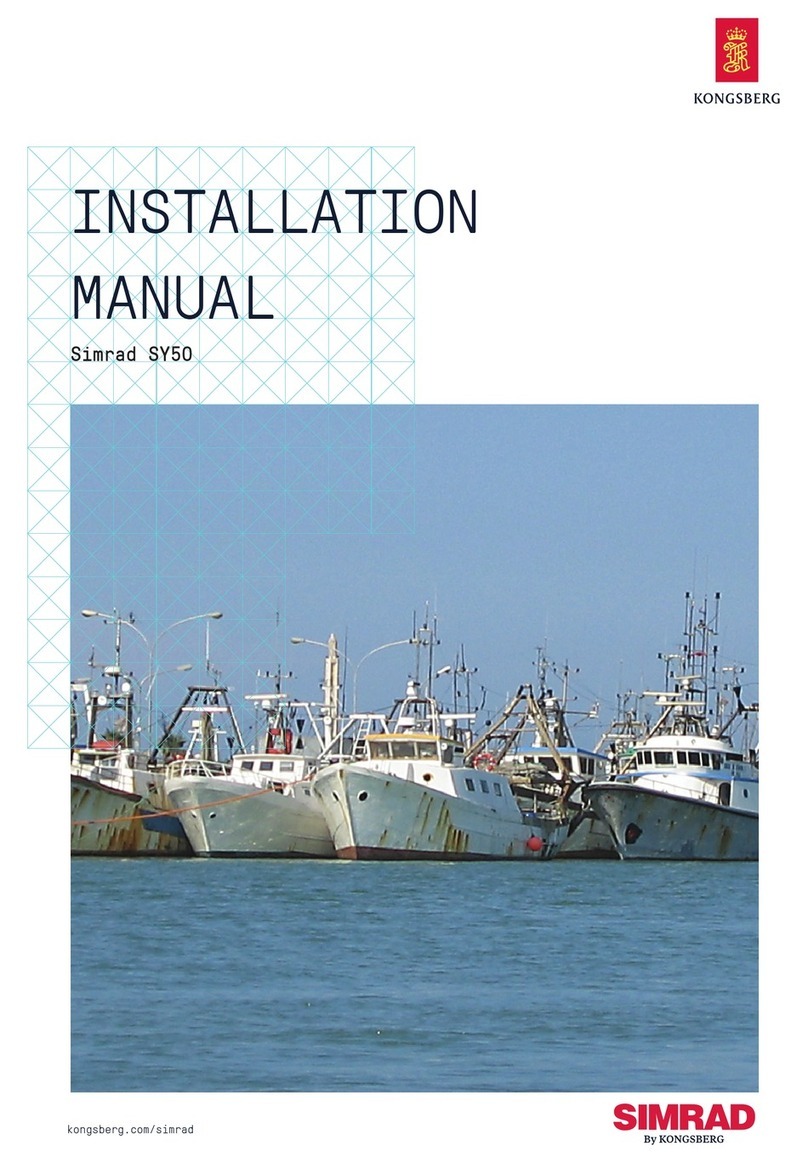
Kongsberg
Kongsberg Simrad SY50 installation manual
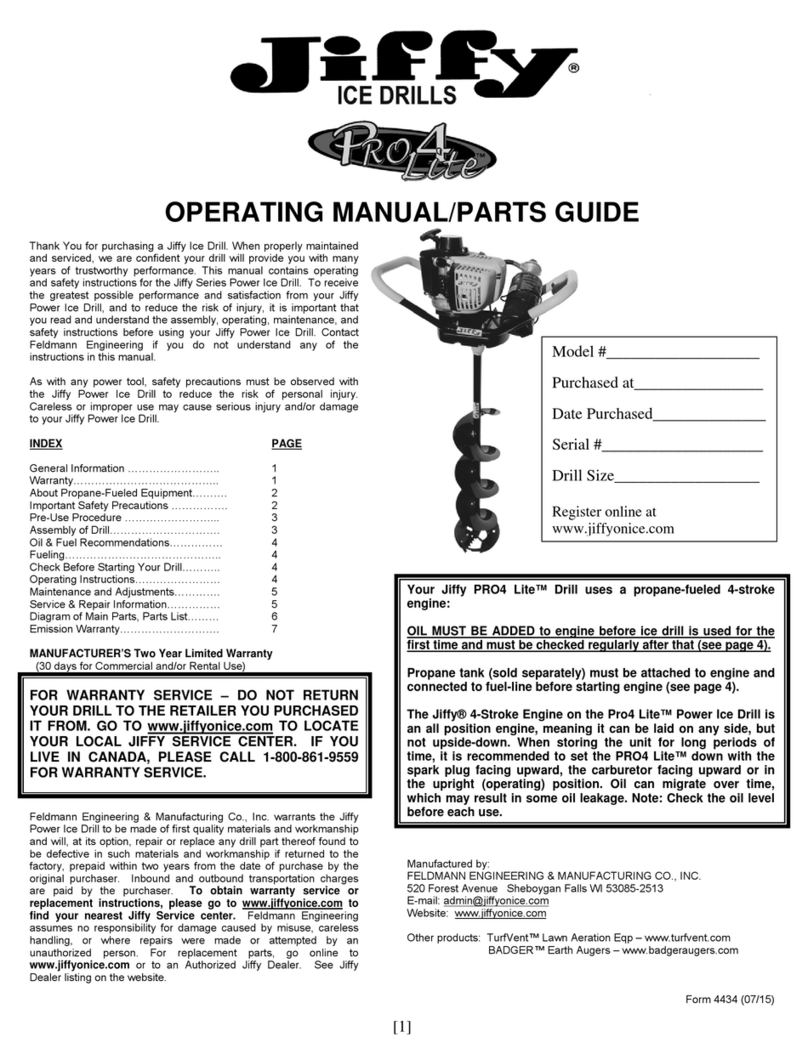
Jiffy
Jiffy Pro4 Lite Operating manual/parts guide

Fishmaster
Fishmaster Pro Series Installation instructions and owner's manual
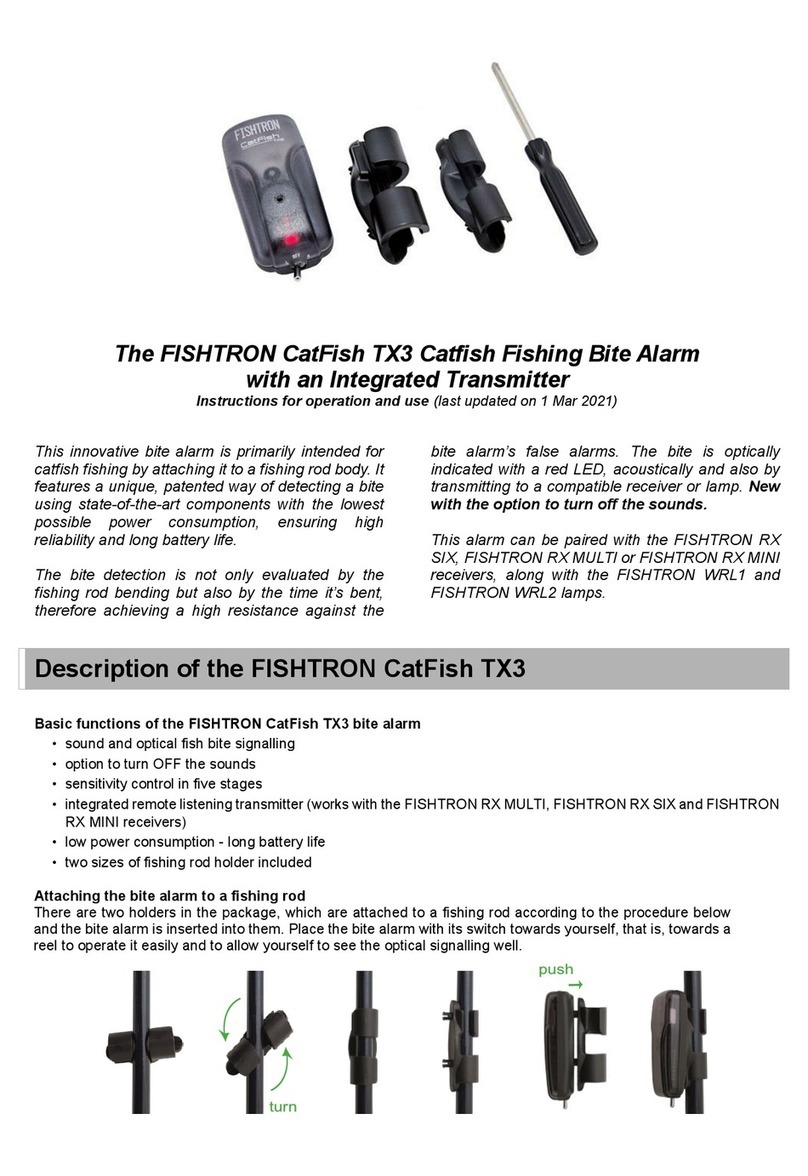
FLAJZAR
FLAJZAR FISHTRON CatFish TX3 Instructions for operation and use

Milwaukee
Milwaukee 2873-20 Operator's manual
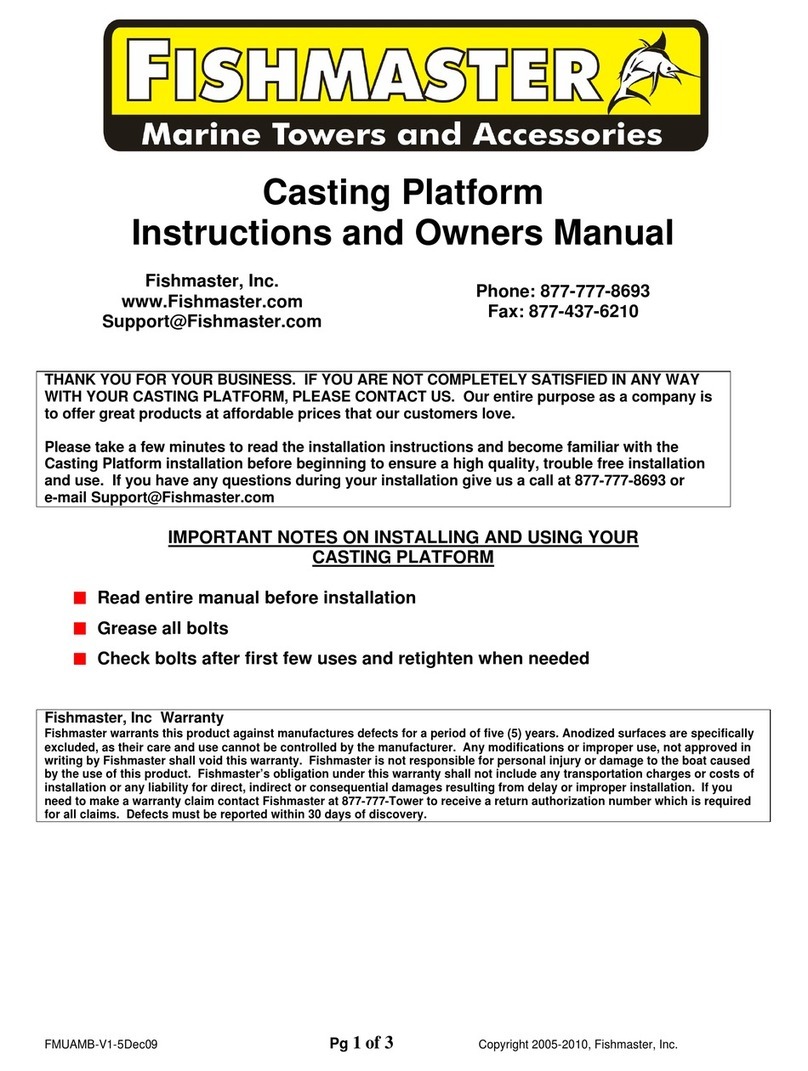
Fishmaster
Fishmaster Casting Platform Instructions and owner's manual
